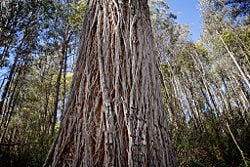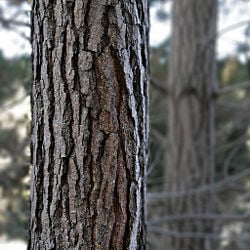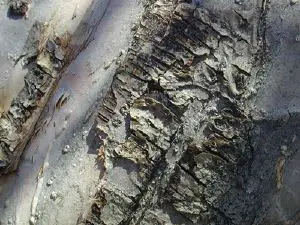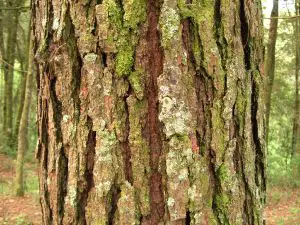Bark is the outermost layer of stems and roots of woody plants such as trees and shrubs. The tissues included depend on how broadly the term is defined and whether considering primary tissues or secondary growth. In general, bark refers to all those tissues outside the vascular cambium, located between the secondary xylem (inwards) and secondary phloem (outwards). However, the term bark is sometimes used to refer to only the cork or to the periderm (cork, cork cambium, and phellederm), or it may be considered to include the vascular cambium.
The outer bark of dead cork cells gives the pattern seen in trees.
In this article, bark will refer to all the tissues covering stems and roots of woody plants outside the vascular cambium.
Tissues included in bark
In young stems of woody plants (trees, shrubs, and some perennial vines), the bark is made up of these tissues arranged from the outside surface to the inside:
- Cork - an external, secondary tissue impermeable to water and gases.
- Cork cambium - A layer of cells , normally one or two cell layers thick that is in a persistent meristematic state that produces cork.
- Phellederm - (not always present) A layer of cells formed in some plants from the inner cells of the cork cambium (Cork is produced from the outer layer).
- Cortex - The primary tissue of stems and roots. In stems the cortex is between the epidermis layer and the phloem, in roots the inner layer is not phloem but the pericycle.
- Phloem - nutrient conducting tissue composed of sieve tub or sieve cells mixed with parenchym and fibers.
In primary tissues, thus, the bark includes the phloem, cortex, and epidermis, and the bark of roots would be the cortex and epidermis. In roots with secondary growth, the bark includes the phloem and the periderm (cork cambrium, cork, and phellderm).
In old stems, the epidermal layer, cortex, and primary phloem become separated from the inner tissues by thicker formations of cork. Due to the thickening cork layer, these cells die because they do not receive water and nutrients. This dead layer is the rough corky bark that forms around tree trunks and other stems. In smaller stems and on typically non-woody plants, sometimes a secondary covering forms called the periderm, which is made up of cork cambian, cork, and phelloderm. It replaces the dermal layer and acts as a covering much like the corky bark, it too is made up of mostly dead tissue. The skin on the potato is a periderm.
The bark of some trees is edible.
The vascular cambium is the only part of a woody stem where cell division occurs. It contains undifferentiated cells that divide rapidly to produce secondary xylem to the inside and secondary phloem to the outside.
Along with the xylem, the phloem is one of the two tissues inside a plant that are involved with fluid transport. The phloem transports organic molecules (particularly sugars) to wherever they are needed.
Cork, sometimes confused with bark in colloquial speech, is the outermost layer of a woody stem, derived from the cork cambium. It serves as protection against damage, parasites and diseases, as well as dehydration and extreme temperatures.
Uses
Cork can contain antiseptics like tannins. Some cork is substantially thicker, providing further insulation and giving the bark a characteristic structure, in some cases thick enough to be harvestable as cork product without killing the tree.
Among the commercial products made from bark are cork, cinnamon, quinine (from the bark of Cinchona) and aspirin (from the bark of willow trees). The bark of some trees notably oak (Quercus robur) is a source of tannic acid, which is used in tanning.
Credits
New World Encyclopedia writers and editors rewrote and completed the Wikipedia article in accordance with New World Encyclopedia standards. This article abides by terms of the Creative Commons CC-by-sa 3.0 License (CC-by-sa), which may be used and disseminated with proper attribution. Credit is due under the terms of this license that can reference both the New World Encyclopedia contributors and the selfless volunteer contributors of the Wikimedia Foundation. To cite this article click here for a list of acceptable citing formats.The history of earlier contributions by wikipedians is accessible to researchers here:
The history of this article since it was imported to New World Encyclopedia:
Note: Some restrictions may apply to use of individual images which are separately licensed.



